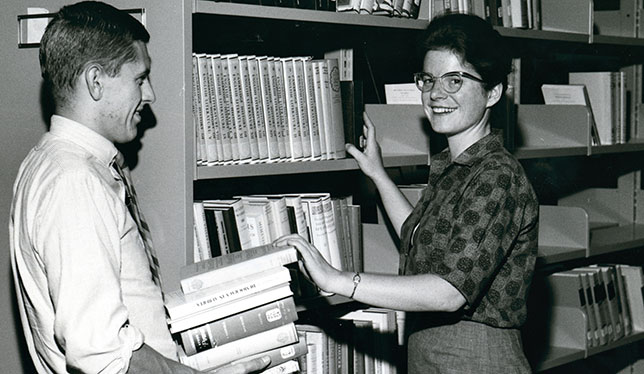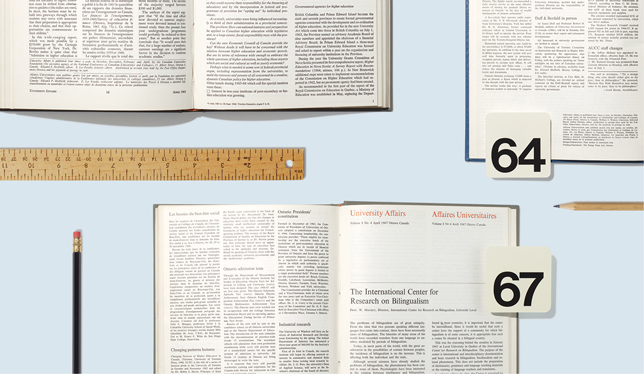The approach of Canada’s 150th anniversary, or sesquicentennial, provides an opportunity to reflect not just on where the country is heading, but also on where it’s been. To that effect, we decided to take a look back in the pages of University Affairs circa 1964 to 1967 to see what was preoccupying universities in the lead-up to Canada’s centennial.
The magazine itself was rather different back then – more a newsletter for senior administrators instead of today’s glossy magazine that, we hope, represents the university community in all its diversity. And, speaking of diversity, the pages of University Affairs 50 years ago were populated almost exclusively by men. Not only were “he” and “him” the pronouns of choice, we could not find a single article written by a woman.
Funding, not surprisingly, was an issue in the mid-1960s, both for university operations and research. The Medical Research Council, precursor to the Canadian Institutes of Health Research, had just been created in 1960. Canada’s two other main research funding agencies, the Social Sciences and Humanities Research Council and the Natural Sciences and Engineering Research Council, wouldn’t exist until 1977 and 1978, respectively.
The period also saw an incredible churn in the makeup of universities, both in terms of the consolidation or federation of existing institutions and the creation of new ones. In a roundup of the 1965-66 academic year published in October 1966, the magazine listed 22 institutions that were either new (Simon Fraser University, University of Calgary, York University) or had their status altered (Mount Saint Vincent College, for example, became Mount Saint Vincent University and Lakehead College of Arts, Science and Technology became Lakehead University).
Themes of a more general and societal nature were also reflected in the pages of University Affairs. Canadian unity was a recurring topic, but more striking were several meditations on that bewildering cohort of young adults coming of age in the 1960s (note that, according to the Oxford English Dictionary, the term “baby boomer” wasn’t coined until 1970). Following are selected excerpts and direct quotes from the magazine.

University Affairs, December 1964
“The absent-minded professor, partially dressed in an untidy suit and wholly wrapped in his own thoughts…”
– J. A. Corry, principal, Queen’s University
University Affairs, February 1965
The universities: strongholds of the two cultures
Let us acknowledge that there is a tension, a profound malaise, between the two principal ethnic groups of the country. This tension is not lessened by focusing on misunderstandings, which may originate on either side; certainly not by exaggerating them, as is sometimes done. Passion seldom results in rational behaviour, and certainly not in this case. …
Faced with this mood, this strained situation, what must we do, we who are gathered together in our capacity as members of the university community? First of all, is this a problem for us? Have our institutions of higher learning, as such, any special responsibility in this matter? And what of us as individuals engaged in higher education? What do we think? What have we done? What do we plan to do? …
In all fields, the universities have a leadership role to play. At the present time nothing is more important than promoting harmony between the two cultures of Canada. We are all men of good will. And we love Canada dearly. May the achievement of peace be our memorial!
– Msgr. Irénée Lussier, rector, Université de Montréal
No new graduate schools
Although the number of graduate students both at the master’s and PhD levels is increasing and may reach a total figure of 20,000 by 1970-71, there would appear to be little need for the establishment of new graduate schools. The present institutions are well distributed across Canada. All of them are operating well below optimum size and the quality and efficiency of their work would benefit greatly from expansion.
– H. G. Thode, president, McMaster University
Government support of science
A recent release of the Dominion Bureau of Statistics details the expenditures by the federal government on scientific activities. It is expected that expenditures will reach $334 million in 1964-65. … In examining the allocation of funds to “performers” of scientific activities it is revealed that universities and other educational institutions will conduct nine percent of federally financed scientific activity in 1964-65.
University Affairs, April 1965
In the public domain
The most important change distinguishing the new universities from the old is that the new universities are in the public domain in a manner, and to a degree, uncommon to the old. It is not simply that they are public institutions initiated and sustained by government grants. This was the case for many universities in the past. But most of the universities begun in the last decade … have stirred a wide interest and a sense of proprietorship in the communities in which they were established. The result is that these universities are in the public domain; not simply as public institutions, but as community projects. …
Part of the mystique of the university has been torn away. The old university with its absent-minded professors and its ivy-covered walls is a romantic picture that stirs pleasant memories, but little enthusiasm as a model for today’s development. The new universities are “public property” in a sense that was not true of universities in the past. As a consequence, all aspects of the university’s life and work are being regarded afresh by many people unfamiliar with university traditions. And while these people are not unsympathetic with what they see, they do not hesitate to criticize sharply when they see fit. The university no longer enjoys an isolated and protected position in the community.
– Murray G. Ross, president, York University
“A president selected by a board of governors may be good or he may be bad, but he comes into power the wrong way – he is imposed.”
– Arthur Lower, emeritus professor of history, Queen’s University
Students and social action
As I write this, over 3,000 students and young people are holding a demonstration in front of the Parliament buildings in Ottawa as a gesture of solidarity with civil rights workers in Alabama. The march, a simple, moving, silent affair … illustrates in a dramatic manner a new social consciousness that is developing among Canada’s university students.
– Stewart Goodings, past president, Canadian Union of Students
“The situation of the instructor today is a very different one. Instead of having a status of a door-to-door pencil salesman, he now has – or soon will have – approximately the social status of a free taxi in a pouring rain.”
– H. Northrop Frye, principal, Victoria University

University Affairs, October 1965
The president
“One man is too frail a bond between something as opinionated as a faculty and something as powerful as a board of governors.”
– J. R. Nursall, professor of zoology, University of Alberta
University Affairs, December 1965
“It sometimes seems that our PhD programs are designed to train future university professors who will be particularly interested in, and good at, training future university professors who will be particularly interested in, and good at, training university professors who will be – and so on and so on.”
– L. H. Cragg, president, Mount Allison University
Enrolment, 1965-66
The Dominion Bureau of Statistics estimates that total full-time enrolment in Canadian universities and colleges as of December 1, 1965, was 206,000. Of these, 32 percent were women students and eight percent were engaged in graduate studies.
University Affairs, October 1966
Review of the University Year, 1965-66
For the first time Canadian governments (provincial and federal) and the public were made fully aware of what the minimum costs of higher education in Canada would be over the next 10 years. To most people outside the universities these figures were startling in their magnitude. The Bladen Report [the report of the Bladen Commission, Financing Higher Education in Canada, 1965], showed clearly that costs would mount rapidly as a result of increasing enrolments, increasing costs per student, increasing financial requirements of research and demands for more aid to students. It was clear also that government would have to bear the major share of these increasing costs.

University Affairs, October 1967
The signal event of the 1966-67 year was a change in the financing of postsecondary education. The federal government ceased making direct grants to universities, through the Association of Universities and Colleges of Canada [now Universities Canada, publisher of University Affairs]. Instead, it surrendered four points of personal income tax and one point of corporation tax to the provinces, without stipulation that the amount be spent on postsecondary education. … In making the announcement, Ottawa affirmed its intention to continue direct support for research, and its intention to assume direct responsibility for adult retraining. The change in financing affected all provinces but Quebec, which had concluded a similar agreement with the federal government a year earlier. It took both provincial politicians and the university community by surprise.
A centennial view of the role of universities in the development of Canada
Higher education in Canada will not “come of age” until its academic programs pay a good deal more attention than they do now to the particular problems and possibilities of the Canadian society, and the North American civilization of which the Canadian society forms a part. …
It is high time that we “indigenized” at least a part of our undergraduate education, and without neglecting our cultural roots in Europe, recognized much more consciously that Canada is an integral part of the North American civilization. The only way we can be a particularly individual and significant part of that civilization is by exploiting to the full our bilingual and multicultural potentiality, if we have the wit to do it.
– G. C. Andrew, executive director, AUCC
The big shake-up
I do not deny for a moment that the last few years have been a trying time for university students. The distractions of rapid growth have interfered somewhat with the attention the student reasonably expects from his teacher. The student, like everyone else needs, even if he sometimes does not want, firm and fixed points of reference by which to order his affairs. But nearly everything is in flux. Stability is lacking in the university world.
In fact, the flux and instability are not confined to university campuses. Indeed, I do not think that the restlessness so evident among students today is primarily caused either by what the university does to them or fails to do for them. … The main root of the distress is the severe shaking up of the society in which we live.
The student does not know at all what kind of a world his will be, except that it will not be his father’s world. He does not know whether it will give him a fair chance at meaningful work, or how far the ideals and standards by which we have given meaning to our work and our lives in the historic past are a good enough response to the conditions of life he will face in the future. How could he know since the future is unpredictable as never before in our memory.
– J. A. Corry, principal, Queen’s University
The cultural value of scientific research
Today it is widely recognized that investing in education and scientific research goes hand in hand with a healthy economy, and that no nation or people can hope to enjoy the material benefits of science without the expertise necessary to interpret and apply the latest advances made at home or elsewhere. … But material gains are not the only benefits. Basic research, i.e. pure research in particular, broadens the intellectual horizons of mankind by continuously expanding the scope of our knowledge, and greatly contributes to our mastery of the universe and ourselves. It is the cornerstone of our culture and civilization.
– Louis-Paul Dugal, vice-dean, faculty of medicine, Université de Sherbrooke
University Affairs, December 1967
Some hints on decoding “Student Power”
Today, the natives are restless – not to say tempestuous. The jungle drums are beating out a message that reads Student Power. … The insistent and ever-louder message of the drums, summoning the rubes to action, is inescapable. The thickest ivy-covered wall cannot dull the sound, the most impervious ivory-towered, ivory-headed administration cannot fail to be penetrated. I hear the message loud but, I must confess, I fail to hear it altogether clear. Since my hearing is normal, it must be that the drum beaters are using either a language foreign to me or a code with which I am not familiar.
How do we decode the message contained in the slogan Student Power? The students themselves have provided us with the cipher. In its crudest form it is intended to read: Down with those magnates of the corporate capitalist world who have insinuated themselves on to the governing boards of our universities; and up with student representatives on such boards and every other decision-taking entity within the university.
– J. E. Hodgetts, principal, Victoria University
What society expects from academia
University should not be a place where academia shuts itself away from the world. Every university, as the very term suggests, must have an international dimension. … Universities are borderless communities made up of teachers and students.
– Jean-Guy Cardinal, dean, faculty of law, Université de Montréal
